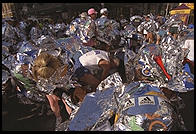

|
Glossaryfor Philip and Alex's Guide to Web Publishing |
registration_date would contain information only of type
date. A data model is interesting because it shows what
kinds of information a computer application can process. For example,
if there is no place in the data model for the program to store the IP
address from which content was posted, the publisher will never be able
to automatically delete all content that came from the IP address of a
spammer.
Historical Note: Lisp programmers forced to look at Perl code would usually say "if there were any justice in this world, the guys who wrote this would go to jail." In a rare case of Lisp programmers getting their wish, in 1995 Intel Corporation persuaded local authorities to send Randal Schwartz, author of Learning Perl (O'Reilly 1997), to the Big House for 90 days (plus 5 years of probation, 480 hours of community service, and $68,000 of "restitution" to Intel). Sadly, however, it seems that Schwartz's official crime was not corrupting young minds with Perl syntax and semantics. At MIT, our Unix sysadmins periodically run a program called "crack" that tries to guess our passwords. When crack is successful, the sysadmins send us email saying "your password has been cracked; please change it to something harder to guess." Obviously they do not need our passwords since they have root access to all the boxes and can read any of our data. At MIT, you get paid about $50,000/year for doing this. In Oregon if you do this for a multi-billion dollar company that has recently donated $100,000 to the local law enforcement authorities, you've committed a crime. See http://www.lightlink.com/spacenka/fors/ for more on State of Oregon v. Randal Schwartz.